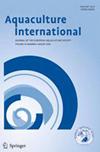摘要
绿贻贝(Perna viridis)是菲律宾北棉兰老岛单孔对虾(Penaeus monodon)综合多营养水产养殖(IMTA)池塘系统的一种很有前景的生物修复剂。本研究通过评估贻贝在不同放养密度(0-对照组、10 和 15 只贻贝-200 升)下去除单节对虾池塘养殖介质(水和土壤)中的总异养菌(THB)、弧菌和浮游生物的效率,为完善 IMTA 池塘技术做出了贡献。实验是在塑料桶的微观世界条件下进行的,72 小时内监测生物修复情况,24 小时内评估过滤率。55E + 03 THB;5.33E + 01 至 7.70E + 02 弧菌)高于 10 贻贝-200 L(1.40E + 02 至 5.58E + 02 THB;5.50E + 01 至 1.98E + 02 弧菌)和 15 贻贝-200 L(1.54E + 02 至 5.67E + 02 THB;5.42E + 01 至 1.93E + 02 弧菌)。对照组的浮游生物密度(细胞-毫升-1)(5.8E + 03 至 6.3E + 03)在养殖期间显著增加,而其余处理的浮游生物密度则有所下降,但相互之间没有显著差异(10 贻贝-200 升:5.8E + 03 至 2.2E + 03;15 贻贝-200 升:5.9E + 03 至 1.9E + 03)。24 小时后,15 贻贝-200 L 和 10 贻贝-200 L 的过滤率分别为 239 mL h-1 mussel-1 和 229 mL h-1 mussel-1。培养过程中观察到温度升高,溶解氧略有减少,这可能会影响贻贝的过滤率。与对照组相比,贻贝处理的叶绿素 a 水平也明显较低。结果表明,无论放养密度如何,P. viridis 都能利用 IMTA 池塘培养基有效降低 THB 和弧菌(72 小时)以及浮游生物密度(24 小时)。不过,在进行生物修复时,建议采用 10 只贻贝-200 升的放养密度,以尽量减少 IMTA 池塘系统中的竞争和废物积累。The green mussel Perna viridis (green mussel) is a promising bioremediator for the Penaeus monodon (giant tiger shrimp) Integrated Multitrophic Aquaculture (IMTA) pond systems in Northern Mindanao, Philippines. This study contributes to refine an IMTA pond technology by assessing the efficiency of P. viridis in removing total heterotrophic bacteria (THB), Vibrio, and plankton at different stocking densities (0-control, 10, and 15 mussels−200 L) from P. monodon pond culture medium (water and soil). Experiments were conducted under microcosm conditions using plastic drums, with bioremediation monitored over 72 h and filtration rates assessed over 24 h. THB and Vibrio counts (LOG CFU·mL⁻1) in the water were significantly higher in control (1.47E + 02 to 1.55E + 03 THB; 5.33E + 01 to 7.70E + 02 Vibrio) than in 10 mussels−200 L (1.40E + 02 to 5.58E + 02 THB; 5.50E + 01 to 1.98E + 02 Vibrio) and 15 mussels−200 L (1.54E + 02 to 5.67E + 02 THB; 5.42E + 01 to 1.93E + 02 Vibrio). Plankton densities (cells·mL⁻1) in the control (5.8E + 03 to 6.3E + 03) significantly increased towards the culture period, while the remaining treatments declined but no significant difference with each other (10 mussels−200 L: 5.8E + 03 to 2.2E + 03; 15 mussels−200 L: 5.9E + 03 to 1.9E + 03). Filtration rates after 24 h were 239 mL h⁻1 mussel⁻1 at 15 mussels−200 L and 229 mL h⁻1 mussel⁻1 at 10 mussels−200 L. Elevated temperature and slightly reduced dissolved oxygen were observed during the culture, possibly affecting the filtration rates of the mussels. Chlorophyll a levels were also significantly lower in mussel treatments compared to the control. The results indicate that P. viridis, regardless of the stocking density, effectively reduced THB and Vibrio (72 h) and plankton densities (24 h) using IMTA pond culture medium. However, the 10 mussels−200 L stocking density is recommended for bioremediation to minimize competition and waste accumulation in the IMTA pond system.

 求助内容:
求助内容: 应助结果提醒方式:
应助结果提醒方式:


